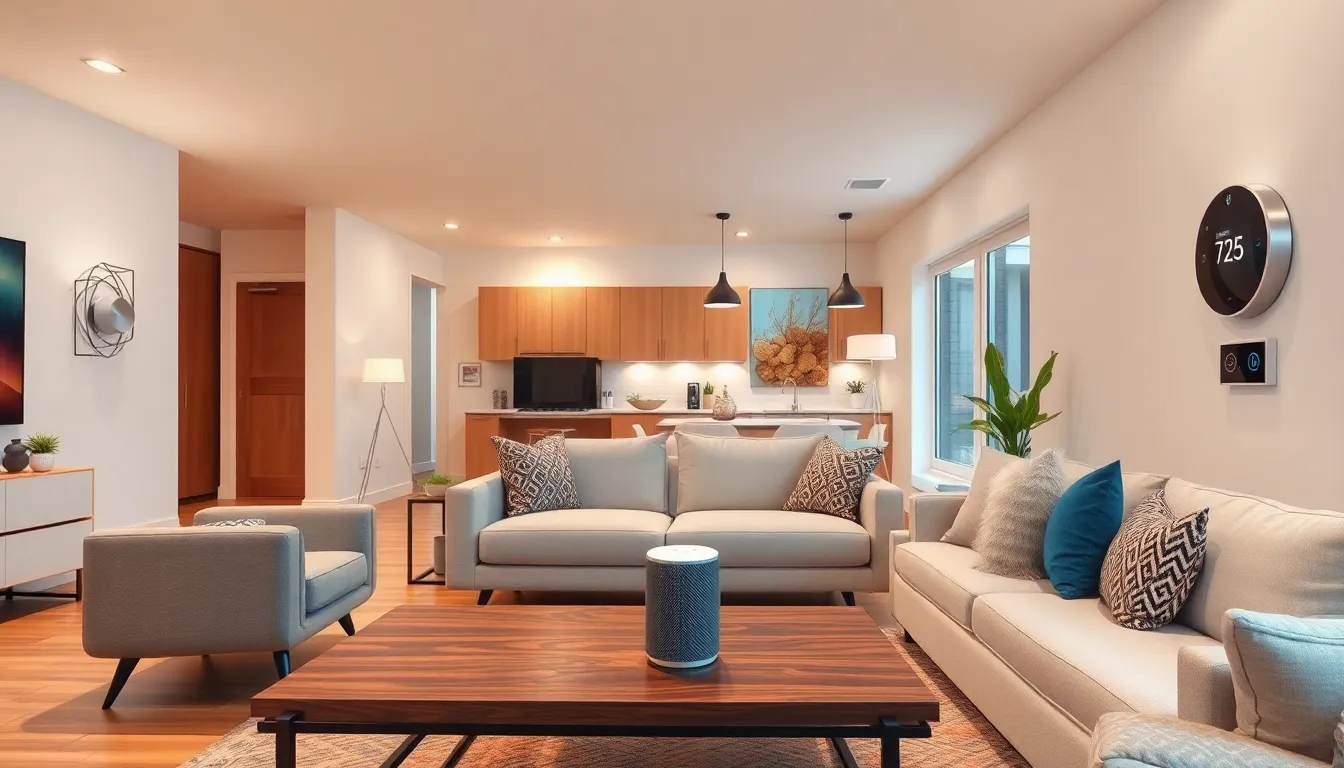Imagine a world where your coffee brews itself while you hit the snooze button for the third time. Home automation makes this dream a reality, turning your humble abode into a smart sanctuary that caters to your every whim. From lighting that knows when you’ve entered the room to security systems that can spot a cat burglar faster than you can say “who’s there,” the benefits are endless.
With technology advancing faster than a toddler on a sugar rush, it’s time to embrace the future of living. Home automation not only adds convenience but also enhances energy efficiency and security. So why not let your home do the heavy lifting? After all, if your fridge can remind you to buy milk, it’s practically begging for a promotion. Get ready to explore how smart technology can transform your space into a haven of comfort and efficiency.
Table of Contents
ToggleOverview of Home Automation
Home automation refers to the integration of technology into the daily management of household systems. Devices and systems automatically control lighting, heating, and appliances for efficiency and convenience. Smart home technology enables remote monitoring and control, allowing homeowners to manage systems through smartphones or voice commands.
Energy efficiency significantly improves with home automation. Smart systems adjust energy usage based on real-time data, reducing waste. For example, smart thermostats learn user habits to optimize heating and cooling schedules, resulting in savings on energy bills.
Security is another key benefit of home automation. Smart cameras and alarms allow users to monitor their homes in real-time. When sensors detect unusual activity, alerts are sent instantly to homeowners’ devices, enabling prompt responses.
Comfort is enhanced through automated routines. Automated lighting can adjust to different times of the day, creating a welcoming environment. Additionally, smart speakers can play preferred music or control other smart devices with voice commands, streamlining everyday tasks.
Accessibility also improves with home automation, benefiting individuals with mobility challenges. Voice-activated devices provide hands-free control, making home management simpler for all residents.
Cost savings are evident in various aspects of home automation. High-efficiency appliances consume less energy, resulting in lower monthly utility costs. Over time, these savings accumulate, justifying the initial investment in smart technology.
As technology continues to advance, the possibilities for home automation expand. Integrating more devices enhances the interconnectedness of systems, creating entirely cohesive living environments. Automation not only provides comfort but also increases home value, making it an attractive feature for potential buyers.
Benefits of Home Automation

Home automation significantly improves daily living. This technology streamlines multiple household tasks, ensuring a more enjoyable and efficient lifestyle.
Increased Convenience
Automated systems simplify day-to-day activities. Smart devices allow for remote control of home elements. For example, individuals can use smartphones to adjust lighting before arriving home. Voice-activated assistants help manage routines seamlessly. Many find peace of mind in routine tasks being handled automatically, such as setting up coffee makers or regulating climate controls.
Enhanced Security
Smart technology bolsters home security features. With integrated cameras, homeowners monitor their property anytime from anywhere. Real-time alerts notify them of unusual movements. Motion-activated lights deter potential intruders, enhancing safety. Security systems can also communicate with emergency services directly, ensuring swift responses during crises.
Energy Efficiency
Energy management becomes smarter through automation. Automated thermostats recognize patterns and adjust heating or cooling dynamically. According to studies, homes equipped with smart technology show a notable reduction in energy consumption. Efficient appliances connected to these systems lower utility costs while contributing to environmental sustainability. The cumulative savings provide a quicker return on investment, making home automation financially beneficial.
Popular Home Automation Devices
Home automation devices revolutionize daily tasks, offering convenience and efficiency through technology. Here’s a look at some popular options.
Smart Lighting Solutions
Smart lighting solutions enhance ambiance and energy efficiency in homes. These systems allow users to control brightness levels and color via smartphones or voice commands. Additionally, automatic scheduling adjusts lighting based on time of day, optimizing energy consumption. Brands like Philips Hue provide customizable features, enabling users to create unique scenes for different occasions. Enhanced security kicks in with motion sensors, triggering lights when someone enters a room, deterring potential intruders.
Smart Thermostats
Smart thermostats adapt to user preferences, significantly reducing energy costs. These devices learn habits over time and adjust heating or cooling accordingly, ensuring optimal comfort. Companies such as Nest and Ecobee offer models that can be controlled remotely, providing real-time updates on energy usage. Additionally, geofencing technology allows thermostats to adjust when residents are home or away, further contributing to savings. As homes require less energy, the impact on utility bills becomes noticeable.
Security Cameras and Alarms
Security cameras and alarms provide peace of mind through constant monitoring. Many systems offer live feeds accessible from smartphones, allowing users to check on their homes anytime. Advanced features like motion detection send alerts to users when unusual activity occurs. Notable brands, including Ring and Arlo, emphasize integrated solutions that connect with other smart devices for enhanced security. These systems not only deter crime but also enhance overall safety, making homes safer environments.
Challenges in Home Automation
Home automation faces several challenges that can hinder its effectiveness and consumer adoption. Addressing interoperability issues and privacy concerns becomes essential for maximizing the benefits of smart technology.
Interoperability Issues
Interoperability among devices presents significant challenges in home automation. Many manufacturers develop proprietary systems, leading to incompatibility between devices. This fragmentation can frustrate users who expect seamless integration. Some homeowners invest in multiple devices from different brands, only to discover limitations in functionality. Industry standards are still evolving, resulting in communication gaps between devices that rely on various protocols. Consequently, a lack of universal compatibility creates hurdles in creating cohesive smart home ecosystems.
Privacy Concerns
Privacy concerns dominate discussions around home automation. Smart devices often require access to personal data to function effectively, raising questions about data security. Users worry about unauthorized access to their information, especially with devices that continuously monitor and collect data. Breaches of security can occur, exposing sensitive information to cyber attacks. Additionally, manufacturers may share user data with third parties, compounding privacy risks. Ensuring adequate protection while utilizing these devices remains a top priority for consumers and developers alike.
Future of Home Automation
The future of home automation promises to enhance everyday living through smarter technology. With developments in connectivity and integration, a more intuitive home environment is on the horizon.
Trends to Watch
Artificial intelligence plays a pivotal role in shaping home automation. AI-driven devices learn from user behavior and adapt to preferences, making automation more personalized. Voice control is gaining traction, with increasing accuracy in understanding natural language commands. Sustainability trends emphasize the importance of energy-efficient solutions, pushing manufacturers to create smart devices that minimize energy consumption. Interconnectivity among devices continues to improve, fostering a seamless ecosystem where smart appliances, security systems, and energy management tools work cooperatively. These trends signal a transformative shift in how consumers interact with their homes.
Innovations on the Horizon
Emerging technologies are set to revolutionize home automation. The integration of 5G networks will enable faster communication between devices, reducing latency and improving functionality. Advanced sensors are being developed that offer real-time data on home conditions, such as air quality and energy usage. Robotics is also advancing, with vacuum and lawn care robots becoming more sophisticated in their performance. Smart appliances equipped with machine learning will predict needs and optimize their operation for efficiency. Furthermore, augmented reality may enhance user interfaces, making controlling smart systems more intuitive and engaging. These innovations aim to create seamless, efficient, and highly responsive home environments.
Home automation represents a remarkable shift in how individuals manage their living spaces. By integrating technology into daily routines, it not only enhances convenience but also promotes energy efficiency and security. The ability to control various systems remotely empowers homeowners to create a more personalized and responsive environment.
As advancements continue to emerge, the potential for smarter homes expands. With innovations in AI and connectivity, future home automation systems promise even greater integration and user experience. Embracing this technology can lead to significant cost savings and improved quality of life. The journey toward a fully automated home is just beginning, and the benefits are too compelling to ignore.






